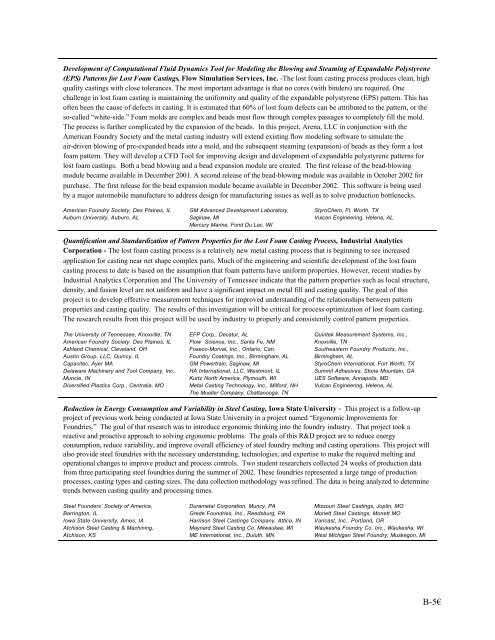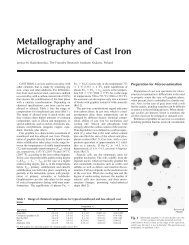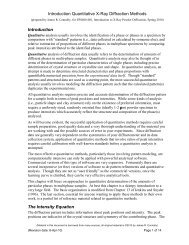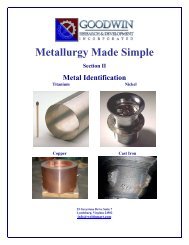ITP Metal Casting: 2002 Metal Casting Industry of the Future ...
ITP Metal Casting: 2002 Metal Casting Industry of the Future ...
ITP Metal Casting: 2002 Metal Casting Industry of the Future ...
Create successful ePaper yourself
Turn your PDF publications into a flip-book with our unique Google optimized e-Paper software.
Development <strong>of</strong> Computational Fluid Dynamics Tool for Modeling <strong>the</strong> Blowing and Steaming <strong>of</strong> Expandable Polystyrene<br />
(EPS) Patterns for Lost Foam <strong>Casting</strong>s, Flow Simulation Services, Inc. -The lost foam casting process produces clean, high<br />
quality castings with close tolerances. The most important advantage is that no cores (with binders) are required. One<br />
challenge in lost foam casting is maintaining <strong>the</strong> uniformity and quality <strong>of</strong> <strong>the</strong> expandable polystyrene (EPS) pattern. This has<br />
<strong>of</strong>ten been <strong>the</strong> cause <strong>of</strong> defects in casting. It is estimated that 60% <strong>of</strong> lost foam defects can be attributed to <strong>the</strong> pattern, or <strong>the</strong><br />
so-called “white-side.” Foam molds are complex and beads must flow through complex passages to completely fill <strong>the</strong> mold.<br />
The process is fur<strong>the</strong>r complicated by <strong>the</strong> expansion <strong>of</strong> <strong>the</strong> beads. In this project, Arena, LLC in conjunction with <strong>the</strong><br />
American Foundry Society and <strong>the</strong> metal casting industry will extend existing flow modeling s<strong>of</strong>tware to simulate <strong>the</strong><br />
air-driven blowing <strong>of</strong> pre-expanded beads into a mold, and <strong>the</strong> subsequent steaming (expansion) <strong>of</strong> beads as <strong>the</strong>y form a lost<br />
foam pattern. They will develop a CFD Tool for improving design and development <strong>of</strong> expandable polystyrene patterns for<br />
lost foam castings. Both a bead blowing and a bead expansion module are created. The first release <strong>of</strong> <strong>the</strong> bead-blowing<br />
module became available in December 2001. A second release <strong>of</strong> <strong>the</strong> bead-blowing module was available in October <strong>2002</strong> for<br />
purchase. The first release for <strong>the</strong> bead expansion module became available in December <strong>2002</strong>. This s<strong>of</strong>tware is being used<br />
by a major automobile manufacture to address design for manufacturing issues as well as to solve production bottlenecks.<br />
American Foundry Society, Des Plaines, IL GM Advanced Development Laboratory, StyroChem, Ft. Worth, TX<br />
Auburn University, Auburn, AL Saginaw, MI Vulcan Engineering, Helena, AL<br />
Mercury Marine, Fond Du Lac, WI<br />
Quantification and Standardization <strong>of</strong> Pattern Properties for <strong>the</strong> Lost Foam <strong>Casting</strong> Process, Industrial Analytics<br />
Corporation - The lost foam casting process is a relatively new metal casting process that is beginning to see increased<br />
application for casting near net shape complex parts. Much <strong>of</strong> <strong>the</strong> engineering and scientific development <strong>of</strong> <strong>the</strong> lost foam<br />
casting process to date is based on <strong>the</strong> assumption that foam patterns have uniform properties. However, recent studies by<br />
Industrial Analytics Corporation and The University <strong>of</strong> Tennessee indicate that <strong>the</strong> pattern properties such as local structure,<br />
density, and fusion level are not uniform and have a significant impact on metal fill and casting quality. The goal <strong>of</strong> this<br />
project is to develop effective measurement techniques for improved understanding <strong>of</strong> <strong>the</strong> relationships between pattern<br />
properties and casting quality. The results <strong>of</strong> this investigation will be critical for process optimization <strong>of</strong> lost foam casting.<br />
The research results from this project will be used by industry to properly and consistently control pattern properties.<br />
The University <strong>of</strong> Tennessee, Knoxville, TN EFP Corp., Decatur, AL Quintek Measurement Systems, Inc., <br />
American Foundry Society, Des Plaines, IL Flow Science, Inc., Santa Fe, NM Knoxville, TN<br />
Ashland Chemical, Cleveland, OH Foseco-Morval, Inc., Ontario, Can. Sou<strong>the</strong>astern Foundry Products, Inc.,<br />
Austin Group, LLC, Quincy, IL Foundry Coatings, Inc., Birmingham, AL Birmingham, AL<br />
Capacitec, Ayer MA GM Powertrain, Saginaw, MI StyroChem International, Fort Worth, TX<br />
Delaware Machinery and Tool Company, Inc., HA International, LLC, Westmont, IL Summit Adhesives, Stone Mountain, GA<br />
Muncie, IN Kurtz North America, Plymouth, WI UES S<strong>of</strong>tware, Annapolis, MD<br />
Diversified Plastics Corp., Centralia, MO <strong>Metal</strong> <strong>Casting</strong> Technology, Inc., Milford, NH Vulcan Engineering, Helena, AL<br />
The Mueller Company, Chattanooga, TN<br />
Reduction in Energy Consumption and Variability in Steel <strong>Casting</strong>, Iowa State University - This project is a follow-up<br />
project <strong>of</strong> previous work being conducted at Iowa State University in a project named “Ergonomic Improvements for<br />
Foundries.” The goal <strong>of</strong> that research was to introduce ergonomic thinking into <strong>the</strong> foundry industry. That project took a<br />
reactive and proactive approach to solving ergonomic problems. The goals <strong>of</strong> this R&D project are to reduce energy<br />
consumption, reduce variability, and improve overall efficiency <strong>of</strong> steel foundry melting and casting operations. This project will<br />
also provide steel foundries with <strong>the</strong> necessary understanding, technologies, and expertise to make <strong>the</strong> required melting and<br />
operational changes to improve product and process controls. Two student researchers collected 24 weeks <strong>of</strong> production data<br />
from three participating steel foundries during <strong>the</strong> summer <strong>of</strong> <strong>2002</strong>. These foundries represented a large range <strong>of</strong> production<br />
processes, casting types and casting sizes. The data collection methodology was refined. The data is being analyzed to determine<br />
trends between casting quality and processing times.<br />
Steel Founders’ Society <strong>of</strong> America, Durametal Corporation, Muncy, PA Missouri Steel <strong>Casting</strong>s, Joplin, MO<br />
Barrington, IL Grede Foundries, Inc., Reedsburg, PA Monett Steel <strong>Casting</strong>s, Monett MO<br />
Iowa State University, Ames, IA Harrison Steel <strong>Casting</strong>s Company, Attica, IN Varicast, Inc., Portland, OR<br />
Atchison Steel <strong>Casting</strong> & Machining, Maynard Steel <strong>Casting</strong> Co. Milwaukee, WI Waukesha Foundry Co. Inc., Waukesha, WI<br />
Atchison, KS ME International, Inc., Duluth, MN West Michigan Steel Foundry, Muskegon, MI<br />
B-5€








